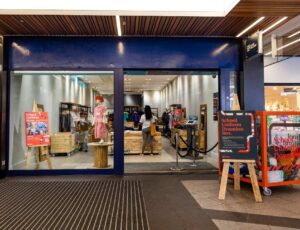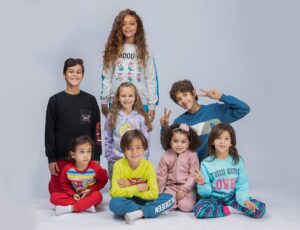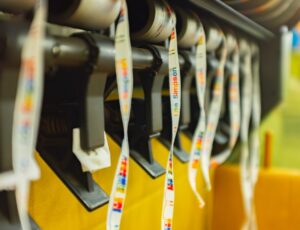
Donald Moore, Chair of B Corp schoolwear supplier One+All, discusses QR codes on schoolwear and whether they will become the norm.
The need for greater supply chain transparency is gaining momentum. Organisations are increasingly being held responsible for their supply chain operations and what is or isn’t being done ethically or sustainably. This is especially the case in the garment industry. The result is that responsible manufacturers are finding ways to prove the ethical and sustainability credentials of their products, with the introduction of QR codes on garments aiding supply chain traceability. Could the use of QR codes be the future for all garments, including schoolwear, and what might it mean for schoolwear procurers?
Why the need for more supply chain traceability?
Consumers are savvier than ever about where their clothes have come from, especially the younger generation who are more likely to purchase from ethical and purpose-led brands. This has led to the rise of the ethical and eco-conscious consumer.
With high profile modern slavery accusations aimed at some of the leading fast-fashion retailers, the garment industry has been forced to respond with greater transparency and traceability. To better manage their reputation, they are increasingly identifying and addressing labour and human rights violations as well as environmental impacts, with some embracing more ethical and sustainable production practices in pursuit of doing the right thing for both people and planet. Transparency and traceability are now imperative for the garment industry, building trust with consumers while ensuring safety and compliance throughout the supply chain.
QR codes in fashion – how are they improving traceability?
QR codes and similar technologies have been embraced by the fashion industry for storytelling. Danish brand Ganni collaborated with Levi to introduce jeans that are available for rent, with the idea being that the garments get better with wear. Using a QR Code like technology, each item’s story is shared so that renters can see who has worn each piece before them.
Although such an approach adds romanticism to a brand, it’s now far more common to see the use of QR codes for supply chain storytelling, with designers tapping into the power of QR codes to demystify the supply chain and provide detailed traceability. By including QR codes on each garment’s care label, it is given a digital passport that allows consumers to find out where each garment was made and, in some cases, its full lifecycle from field to shop. The codes may even include information such as the item’s environmental impact and tips on how to best wash and then dispose of the item at the end of its life.
QR codes on schoolwear garments
So, are QR codes on schoolwear garments the natural next step, and is such an approach necessary for driving a more ethical and sustainable supply chain? Although not in the public eye in the same way as leading fashion brands, schoolwear suppliers are just as impacted by the rise of the ethical and eco-conscious consumer. Customers are increasingly questioning where and how their school uniform has been made and it’s the responsibility of schoolwear suppliers to be fully transparent about their supply chains. And as transparency breeds accountability, greater traceability will likely lead to positive changes both ethically and environmentally.
The use of QR codes on the care labels of school garments can prove ethics and the environment have been considered in their production. An important tool in a school supplier’s armoury, QR codes can enable wearers to find out which factory the garment was made in together with background information about that factory, such as the total number of employees, gender split and working conditions. Such easily accessible supply chain information will not only build trust between the supplier, customer and wearer but will set the schoolwear supplier apart as a company that cares for its workers, customers and the planet.
The role of QR codes in schoolwear procurement
Schools genuinely care about ethics and sustainability. More and more schools include questions about this on their school uniform tender documents, requiring schoolwear buyers to respond to the growing demand for more ethically and sustainably produced garments. The use of QR codes for supply chain traceability provides procurers with the answers they need quickly and easily while supporting the ethical consumer’s needs. They also provide evidence of a purpose-driven brand that cares about doing the right thing rather than a brand that greenwashes and glosses over its ethical credentials (or lack of!).
QR codes – becoming the norm
Far from the latest fad, QR codes are an important tool in delivering supply chain traceability. And as parents and their children begin to learn the story behind where and how their school uniform has been made, the use of QR codes and equivalent technologies will only grow in popularity and necessity, becoming an expected addition to a school uniform care label rather than a welcome surprise.
One+All is introducing QR Codes to its schoolwear garments to provide increased supply chain traceability. For further information on One+All, please click here.














john baines
Here at k.t. labels we have created a revolutionary new label material that simply sticks onto garments. Its washing machine proof, dishwasher proof, and microwave proof. in fact, it sticks on to everything. we are already selling this material for the purpose of identifying school uniforms in the form of name tags. but some of our schoolwear customers are now using the same label material to print their q.r. codes that once stuck on to each piece of school uniform will allow the customer to scan the q.r. code and be directed to the website of the school shop to reorder. it makes sense that the customer is happy to reorder from the original shop where the garment was bought in the first place. in these times of covid-19 more and more customers are ordering online. having a direct link to the supplier is a great bonus to both the customer and retailer.